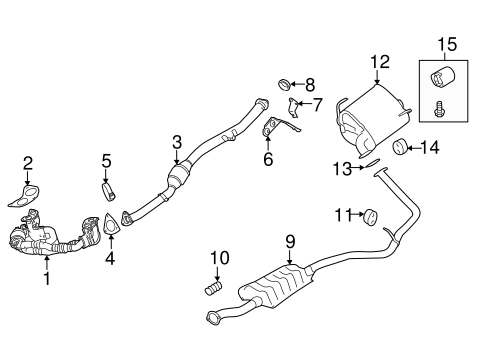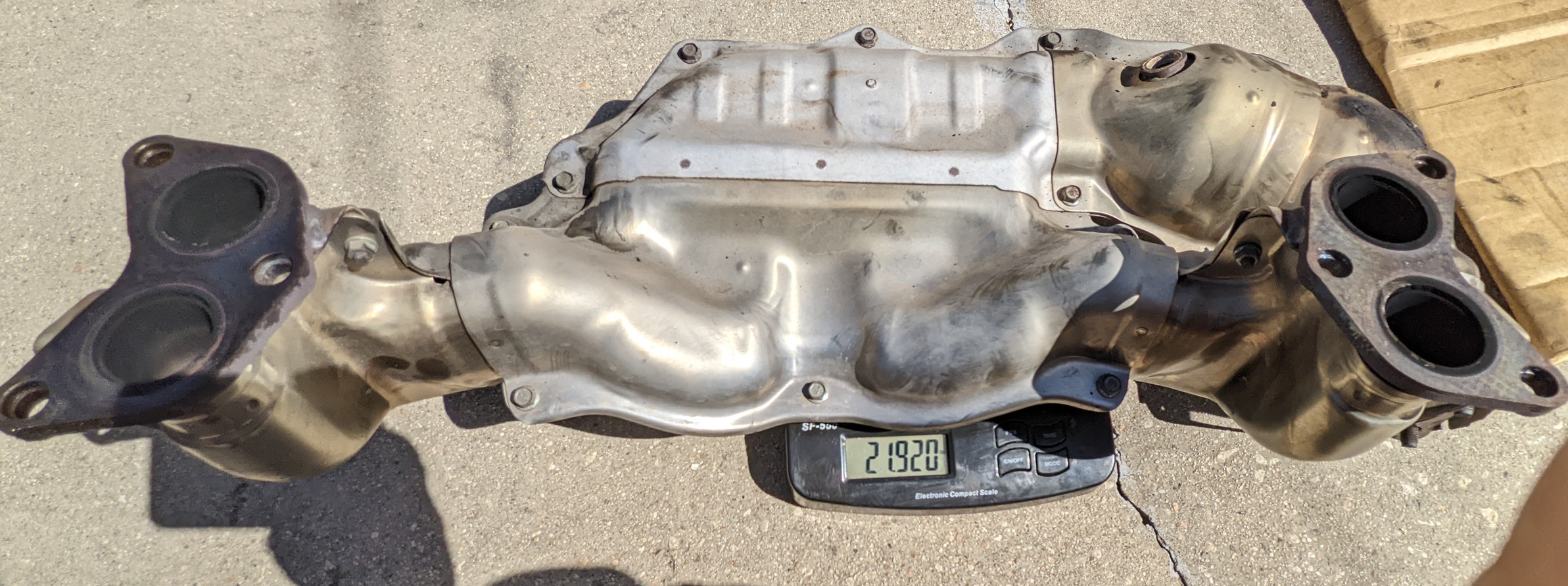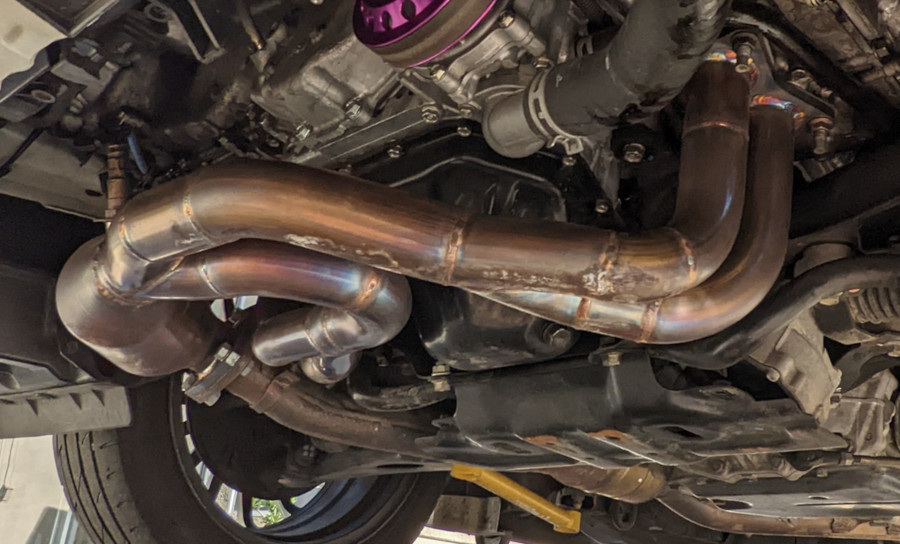
The 2012-2016 Impreza and 2013-2017 Crosstrek have for the most part, 2 inch (50mm) piping throughout the exhaust system.

Subaru Engineers spent some time on this generations exhaust. A complaint about the previous generations' EJ engines were they were gas-hungry and produced poor torque in the lower RPM ranges. The introduction of the FB engines changed those downfalls improving on fuel economy with a more efficient design and more street-able low end torque. I am a firm believer that the design and size of exhaust chosen has a significant effect on helping address that much desired low end torque needed for daily driving.
From the details above, you will note that the OEM exhaust manifolds exit with a 2 inches outlet after the main catalytic converter. Given the application the car was designed for, compact/economy segment. The size of the piping chosen, allows the exhaust gas to maintain a high velocity. This is particularly good for exhaust scavenging, increasing the overall efficiency of the system. The pipe sizing is free flowing enough for the moderately displaced 2L engine in higher RPMs.
There is also the 2.25 piping after the secondary catalytic converter and before the resonator. I believe this segment of the exhaust was purposely added to slow down the exhaust velocity just before the resonator to help reduce some of the sound coming from the engine.
The remaining 2" piping all the way to the muffler would then strike a balance of weight and cost without effecting much of the noise or performance of the engine.
It has been quoted that a 2 or 2.5 litre naturally aspirated engine, needs no more than a 2.5" exhaust diameter piping. Where 3" large diameter piping will free up the exhaust completely allowing for maximum power in high RPMs, it will have an ill effect on low end torque and drivability.
The goal in Naturally aspirated exhaust tuning is to strike a balance between the following:
For a street car, low end torque is desireable for city driving. To tune for low end torque, the exhaust velocity must be considered. Too little (as with the case of oversized piping), then low end torque is lost. On the other hand overly small pipes, will restrict the engines ability to evacuate exhaust causing a reduction in maximum power typically found in high RPMs, not enough flow. The header primary diameter and length seems to affect the initial exhaust velocity the most. One should try to strike a balance to have both low end torque and high end power.
For a street car, consider noise levels when tuning exhaust. It is preferable for daily drivers to manage vibration, drone, and rasp. Even for race cars, it is preferable to run catalaytic converters if not for environmental concerns, but also they help keep the noise down without much downside. While straight pipes theoretically produce the most power, tuners will balance pros and cons. A lesser known downside to running catless pipes is the overbearing smell of petrol.


The OEM exhaust manifold is designed with a few considerations. It is casted steel 4-1 equal-length log-type design fitted with head shields. The casted steel cuts down on cost, holds heat well, and due to its weight also reduces exhaust noise. It weighs ~20lbs. Its primary pipe size is 35mm I.D. and the output after the built-in catalytic converter is 50mm. There is a built in catalytic converter with the OEM exhaust manifold.
They say with naturally-aspirated engines, an exhaust header is typically the biggest power gain one can hope for from any single bolt-on modification. The reasoning behind this is that aftermarket header(s) should theoretically allow for better exhaust flow.
The Inferno Fabrications header (below) is a 4-2-1 equal-length design. Its weight is ~12.5lbs. Its primary pipe size of 41.5mm I.D. and the output after the catalytic converter is measured at 52.5mm I.D.

Typically the volume of exhaust gas of aftermarket headers is greater than that of the OEM manifold. While this is good for high-output scenarios where the engine is running in high RPMs, the extra volume can lower the initial exhaust velocity. This can effect the exhaust scavenging efficiency and also reduce torque at lower RPMs. Ultimately this will effect street-drivability.
A couple of techniques can be used to combat these losses.
The pros of having these aftermarket header(s) is that in high RPM and high load situations, exhaust gas can flow easily producing more peak power. The cons with an aftermarket header however are the possibility of a CEL (check engine light) if it is build without a catalytic converter. Also the aforementioned possibility of torque loss in lower RPMs.
While some people will opt for an un-equal length header purely for sound, this is not recommend for individuals seeking to get the most out of the naturally aspirated engine. For engine longevity, and power, look for an equal length design. Consider the differences between 4-2-1 and 4-1 designs. Also consider cat-less or with a catalytic converter. Without a catalytic converter, you will find the exhaust note to be more raspy.
The front pipe for the FB20B contains a secondary catalytic converter which is situated directly beside the transmission. In the CVT's case, a very hot secondary catalytic converter (from extended hill climbing, or spirited driving) can heat soak the transmission case. Steps should be taken to shield the CVT casing from excessive heat. The front pipes 2" inlet is also the next bottle neck in the exhaust system. Changing the front pipe to a 2.25" or 2.5" may provide more exhaust flow. But be aware a larger diameter piping here may also add to the low-end torque loss.

Typically the mid-pipe and tailpipe will not add any power. Its typically changed out for exhaust note. By removing the resonator in the mid-pipe, you wil find the exhaust sounding extremely raspy. It is suggested that the mid-pipe should have a decent sized resonator to retain drivers sanity and reduce drone.
The tailpipe and muffler choice is really all about looks and sound. Little to no performance gains come from this part. The loudness of your exhaust will depend on the size of muffler you use. It is said that if the tailpipe tip becomes larger than the diameter of the piping, the output sound will be louder. an Example of this are trumpets and brass instruments.
While I am in the early stages of tuning the exhaust on my Impreza, I am able to say with certainty that each exhaust (or intake) modification done, will affect how the engine breathes. In turn the harmonics of the car will change. You may pick up some strange vibrations or droning in certain RPM ranges, sound and vibrations will be different. You may increase or decrease torque and power. Consider the goals of your modifications, and if you can live with differences in power deliver and NVH in search of the perfect exhaust setup. All these should be considered as they will ultimately effect drivability. The closer to the engine, the more gains can be had. Further back, will affect the final sound.
Back to Subaru Impreza Tuner